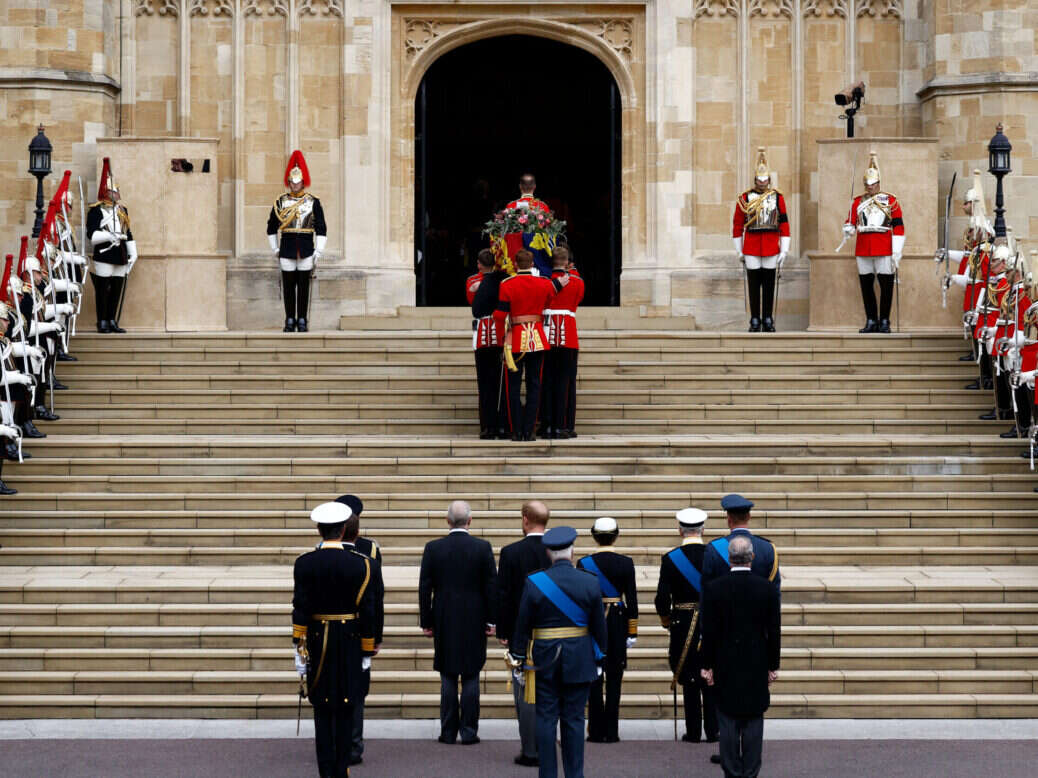
As at all major news organisations, journalists at PA Media and Reuters knew the death of the Queen would be one of the biggest stories they would work on in their careers.
PA editor-in-chief Pete Clifton told Press Gazette: “It would be no exaggeration to say that this is something that we’ve been planning for for, well, it seems like at least a decade or more.”
He added: “It’s what we knew would be the biggest single event that we are probably likely to handle as far as we can see and it proved that way, but it worked very smoothly, I think because of the huge amount of preparation that had gone in.”
Preparation
PA journalists produced a wealth of content in advance of the Queen’s death, including backgrounders, text and video obituaries and picture galleries that were frequently checked and reworked over many years. Clifton said it was more than 100 pieces of text content alone.
Last year PA’s long-time group head of pictures Martin Keene left his role – but he stayed on part-time as editor of major ceremonial events. Clifton said ultimately PA had wanted to maintain some continuity as Keene was the person who had built “the strongest understanding around the procedures around what happens on each day after the death of the Queen”, including in a “significant” document setting out photography and filming positions arranged with Buckingham Palace.
Clifton said this meant “we had a very clear idea about how the days would unfold down to the finest detail”.
He added: “I think this is a classic PA scenario where people expect PA to be at the top of its game. They expect us to have masses of content ready and they expect it to run and to run smoothly and they will make great use of it and that’s exactly what happened.”
Ultimately, Clifton estimated around 150 people – the vast majority of PA’s editorial operation – were involved in the coverage, including 29 photographers and about 17 video journalists. Clifton gave particular praise to royal correspondent Laura Elston who was the only reporter in the Accession Council and who barely left the newsroom “for two weeks basically”.
“Every part of what we do had to respond in some way or other so it’s as big an editorial operation as we’re likely to have until the next major world crisis or disaster,” Clifton said.
“But this is a set piece that we always knew when it happened would be a massive editorial operation and that’s exactly what it was.”
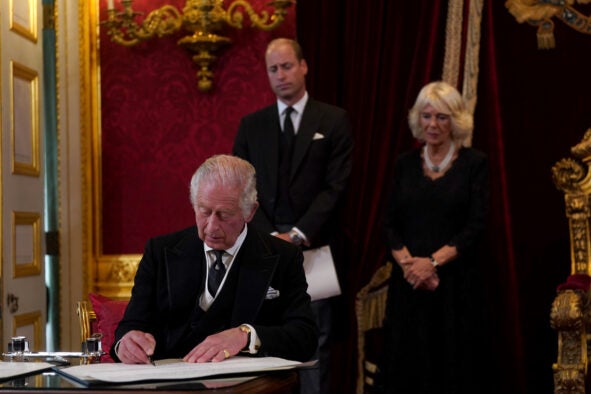
King Charles III signs an oath to uphold the security of the Church in Scotland during the Accession Council at St James’s Palace, London on Saturday 10 September 2022. Picture: PA Wire/Victoria Jones
Meanwhile at Reuters, global visuals editor John Pullman told Press Gazette: “This event has been on the horizon for me throughout my entire career, wherever I’ve worked, but at Reuters we have always had a plan and a very thorough plan.
“But in the middle of this year we began to look at it really closely and intensified our planning for the death of the Queen and what became clear was that every plan can be improved – what we have taken away from this whole experience is no plan is ever finished – so we initiated monthly and weekly planning meetings around how we would react to the death of the Queen and they put us in a really good place for when the event actually happened.”
For example, after the Queen travelled to Balmoral in July and it became clear she was likely to stay longer than usual Reuters sent video journalist Gerhard Mey to check out filming positions outside the castle. He happened to be there on the day of her death and was the only cameraman there for two hours after the initial announcement of concerns for her health, according to Pullman. Mey was joined by photographer Russell Cheyne, and both watched the gradual influx of journalists from further afield throughout that afternoon.
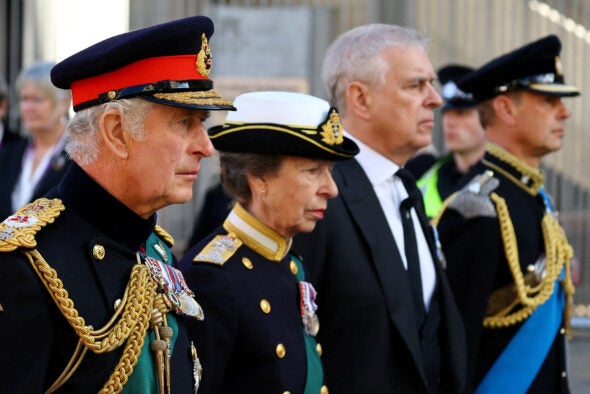
King Charles, Princess Anne, Prince Andrew and Prince Edward follow the hearse carrying the coffin of Britain’s Queen Elizabeth in Edinburgh, Scotland, Britain September 12, 2022. Picture: Reuters/Kai Pfaffenbach
Breaking news
Speculation was rampant that news organisations knew more than they were letting on in the afternoon before the Queen’s death was announced, but Clifton said his team were just piecing it together from everything they knew.
“Enough things had happened during the day that were in full view and then, you know, we also from various other things that we’d heard were certain that these things all added together to make it pretty clear that was going to happen.”
They did learn from sources that there was going to be an announcement after 6pm, and they felt 99% sure what it would be.
PA had someone constantly checking the royal family’s social media, which meant it published a breaking news alert within seconds of the tweet announcing the death going live.
Clifton said: “We were, without doubt, the first media organisation to publish the news. I’d say we were probably five seconds behind it appearing on the Twitter account of the royals.”
Then the “machine kicked in” to get out all the content that was ready to run – which, due to the lead time on the story that afternoon, had been checked yet again.
“It’s awful news… but it happened in a way that worked in our favour if you like, because we had quite a lot of the day to see how the situation was changing and for us to really make sure that everything was ready to go at the push of a button,” Clifton said.

Royal staff place a sign announcing the death of Queen Elizabeth on railings outside Buckingham Palace, after Queen Elizabeth, Britain’s longest-reigning monarch and the nation’s figurehead for seven decades, died aged 96, on September 8, 2022. Picture: Reuters/Henry Nicholls
Of the changing digital world that meant the news broke on Twitter rather than a newsflash to PA and other news organisations, Clifton said: “We understand they have their social accounts that they will be running and where they will be imparting important news and I think if we’re kept properly informed about how something is developing, and we understand when something’s likely to be appearing, then we can be geared up to be very quick from that point. And that suits me.”
Similarly pragmatic, Pullman at Reuters said: “It’s certainly better than putting it on a piece of paper and putting it on a noticeboard outside Buckingham Palace, so I think it’s appropriate for today’s environment to use social media for an announcement like that.”
Unprecedented demand
The preparation paid off: at least 300,000 articles in print and online made use of PA content over the 12 days from the Queen’s death to her funeral.
On 8 September alone, the day of her death, there were 37,000 articles – a record since the agency began tracking usage several years ago, Clifton said.
Meanwhile at Reuters, 84% of all its stories used by clients in that period were related to the Queen’s death. “The rest of the world’s news made up 16% of our usage – not our output, but what customers actually used,” Pullman said. It was the single biggest news story for Reuters since its own tracking began, with 9 September its top day.
Pullman said: “The Queen was the most famous woman in the world and there hadn’t been the death of a monarch for 70 years so it was always going to be an enormous news story.
“I think we were surprised by just how heavily used the story was in places like the US. We all expected the UK and Commonwealth countries to be heavy users of this story but in the US it was very heavily used and that surprised us and it was a nice surprise to have.”
He also noted that Reuters has recently been training its teams to do more than one thing, which in this case ended up meaning its most-used video – of the crowd outside Buckingham Palace singing the national anthem after the Queen’s death was announced – was taken by photographer Toby Melville instead of a traditional video journalist.
People gathered outside Buckingham Palace to sing the national anthem and place flower tributes in honor of Britain's Queen Elizabeth after she died at her home in Scotland at age 96 https://t.co/0JpymjfPOf pic.twitter.com/gL0lJnNAJu
— Reuters (@Reuters) September 8, 2022
Collaboration
Reuters has a commercial partnership with the BBC that meant it could use a lot of its video such as coverage of ceremonial events, with Pullman praising the broadcaster for doing a “brilliant job”.
But a new arrangement was the collaboration between Reuters, PA, AP, AFP and CNN which set up an international video pool to mount live outside broadcast coverage of the day the Queen’s coffin was moved to London and the day of her funeral.
Pullman said it showed how fruitful collaboration can be: “That’s something we haven’t done before and it was a real success. And the beauty of that is it created content that we have archive rights to that could be used more freely than the BBC coverage.
“We’re normally deadly rivals but for those parts of this event we worked together and it worked really well.”
Challenges/innovations
PA also benefited by the story coming just a few months ahead of it launching a live video service for the first time.
Clifton said it had been able to put some of the new kit into action to live-stream some key moments for its customers.
“I think that was a really exciting indicator of what we’ll be doing a lot more in the months ahead,” he said, adding it was something that “even a year ago, we would never have dreamt of being able to do”.
On a technical level, Reuters had to prepare to ensure both that its journalists could file content quickly and that its website would not fall down due to unprecedented demand.
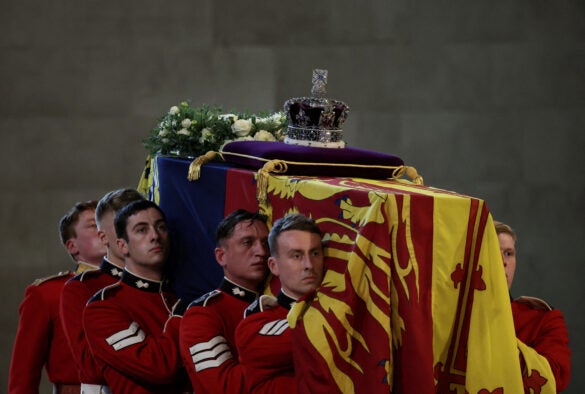
Procession with the coffin of Britain’s Queen Elizabeth arrives at Westminster Hall from Buckingham Palace for her lying in state, in London, Britain, September 14, 2022. Picture: Reuters/Alkis Konstantinidis/Pool
Pullman said: “There were a lot of technical challenges because the demand on bandwidth was enormous but we put engineers out into the field who did a great job of keeping our service operating. That’s not something we normally do, but it worked really well this time.
“We also, because we’d anticipated enormous client interest, [had] done load testing on our delivery systems because we got unprecedented demand and our systems held up, which isn’t always the case in situations like this. Organisations can be overwhelmed but I’m pleased we had prepared for that so it went really smoothly.”
The aftermath
Pullman hopes that the busy newsroom in London during the mourning period will have reminded people of the benefits of being together in an office.
“One of the best things about it was it brought big teams back into our London newsroom, which was probably busier during this period than it had been since before lockdown and I hope that will be one of the legacies,” he said.
“I think it’s helped us remember the value of working together in the same room.”
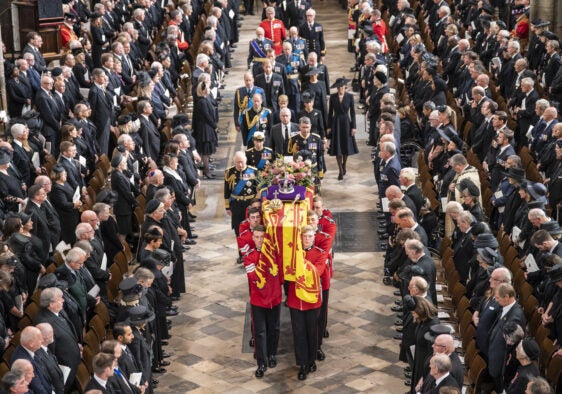
Royals follow behind the coffin of Queen Elizabeth II, draped in the Royal Standard with the Imperial State Crown and the Sovereign’s orb and sceptre, as it is carried out of Westminster Abbey after her State Funeral on Monday 19 September. Picture: Danny Lawson/PA Wire
At PA, Clifton said there will be a “really good look” at the data once “the dust is properly settled” to ensure they learn what content was not so well used, whether publishing things at different times might have worked better, and how customers responded to what got sent out.
Overall, he said: “The thing that I would take away the most is just the enormous pride in how the PA machine just steps into another gear when something like this happens and that will be something that will always be with me.
“It was the most brilliantly professional operation that I’ve been involved in. Although we all knew it was going to be a major, major event everybody was calm, the content all got delivered and people gave up days off, whole holidays off and just stayed and just did the job because of their commitment to PA delivering what was expected and I will always have that as a memory of what it was like over that fortnight. If ever you wanted to see a brilliant team working at its best then it was then.”
Top picture: PA Media/Jeff J Mitchell
Email pged@pressgazette.co.uk to point out mistakes, provide story tips or send in a letter for publication on our "Letters Page" blog
